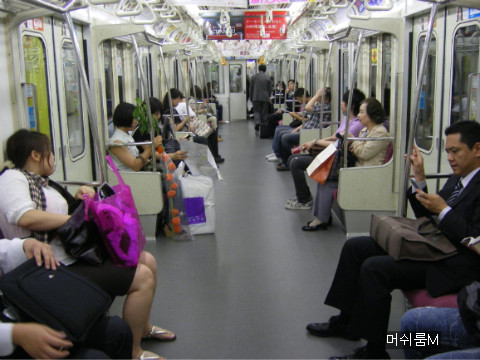How do you get around Seoul? Look around you and you will definitely find a transportation waiting for you to get on and take a look around Seoul!
Seoul has the most excellent transport system that can virtually take people to anywhere they want to go! With these great transportations, getting around Seoul is a cheap and exciting expereince for many tourists!
Here are some great ways to get around Seoul with learning experience!
Taxi
As like in every other countries, Taxi is always available in Korea. There are more than 60000 licensed taxi drivers in Seoul and the basic taxi fair is around 2300 won. There are variety of taxis being introduced to Korea. There are three main categories to Taxis: standard, deluxe and jumbo taxis, which can carry up to about 9 people in one car. As a fast, efficient transportation used worldwide, you can call for a taxi to make a reservation at a certain hour.
Also recently, international taxis are being available with its clear orange color and if you can’t speak Korean or don’t feel comfortable about taking a taxi for a wrong stop, try taking the international taxi, which has drivers who are fluent in English or Japanese. Also if you reserve this taxi on online or the phone, you can get 20% discount of a normal taxis.

Standard taxi

International taxi

Jumbo taxi

Deluxe taxi
Bus
As much as the subway station, Seoul has a very nice and fast bas system. Seoul has been developing to let the bus take the privilege to have their own lanes to help the buses take a faster route in rush hour traffic jams.
Bus is definitely a great way for tourists to take because they can see the views of Seoul in just a ride and can figure out where to go. However, for the tourists or first-time visitors to Korea might have a little difficult time figuring out the Korean bus map written on the bus stops. But there is always a tip that can be used when you have these difficulties! Buses in Korea are separated into categories through their color. Green buses go between major downtown subway stations or bus terminals. Blue buses connect suburban areas to downtown Seoul. Red buses go between outer city areas and downtown Seoul. Yellow buses go on circular routes within downtown Seoul.
With these advices in mind, I suggest you to find a route before you step out into the bigger world of Seoul. For English website for bus journey in Seoul go to: http://english.seoul.go.kr and look for a bus map.



Cycling
Seoul has unique cycling tracks along the Hangang River. Seoul is also preparing for a cycle routes that will be complete around 2012. Cycling is not only a way for a great sight of the large picture of Seoul but also a way for to get your heart pumping and sweat dripping in a city of Seoul!
Also even though you don’t have a bicycle, there is always a bicycle lending spot inside Hangang river where you can borrow a bicycle! The cost is around 4000 won.



Subway
Moving from place to place without the gas eating, inefficient automobiles but with only just 80c and a pair of shoes? Impossible in most places except perhaps New York City. The efficient and extensive subway system in Korea is probably one thing Koreans can brag about.
Since the first subway system in 1863 at London, to the development of Korea’s own subway system in 1974, many people have depended on the use of subways as transportation. Seoul’s subway system, now just having finished its 14th rail, includes over 500 stations. That is almost 1 station per 1.2km2. The most one would need to walk is about 600m which is a distance not worth getting a taxi. Therefore, many prefer to walk and as a result, another eco-friendly technology is created.
“It’s just comfortable.”
“It is representative of Korea.”
“It’s nice”
“Very efficient.”
These are some of the comments reported during a subway ride. One thing that stood out was the efficiency. Seoul’s subway station is cheap to ride, simple to use and pleasant in its clean areas. Although economic developments have raised the cost of public transportation in Korea, 80c is still a nice price to pay for a ride. And even though it gets very crowded in the morning rush hours, subway already knows it and they operate trains more frequently at these times. Even better, for the cost, there is a discount during transitions. Every transitions made between stations cost only a minimal amount rather than a price of another ride. To see one of the best aspects of Seoul with just 80c? To me that’s a nice deal.
The use of T-money is another aspect that gives a clap for the Korean subway system. T-money is a card-based system of payment for transportation within Seoul. With the payment of basic T-money, which is around 2,500 won, you can recharge it in every subway station and use it to make your life easier in only having to carry around a little card to get around Seoul! What an idea!
A cultural contrast is what visitors want at a vacation spot. We don’t go to Hawaii to see the sand. We go there to experience the unique aspects. That is what it is all about, cultural contrast and a Korean subway definitely reflects that.























